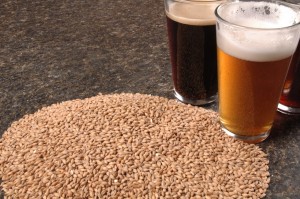
In a previous post I had mentioned using “bugs” in beer. That is not bugs as in “insects”, but other forms of yeast and bacteria rather than the normal brewers yeast. Beer is normally fermented with either a strain of Saccharomyces cerevisiae (ale yeast) or a strain of Saccharomyces pastorianus (lager yeast).
Sometimes you can introduce Lactobacillus delbrukii into your fermenting beer to cause it to sour. You can find L. delbrukii on the husks of barley or malted barley. You can also let the lacto grow in your mash to either add sourness to the beer or just lower the pH of the mash. You might use a sour mash if you have highly alkaline water.
Other interesting micro-organisims that you might encourage in beer would be Pediococcus or Brettanomyces. Pediococcus can produce lactic acids just like lacto can. Brettanomyces (or Brett) is a yeast that can add some rather funky flavors to your beer as well as sourness. Brett is considered a spoilage organism in wine and in many other types of beer.
One reason to promote bacterial growth rather than just adding lactic acid to your beer is to promote depth of flavor. Just like with sourdough bread, you can tell when a sourdough is made from a natural culture versus when lactic acid is added to the dough. Bread with added lactic acid has a sourness that is one dimensional. The same is true with sour beer. Beer that is soured by adding acids to the beer will be one dimensional. Beer that is naturally soured will have complex and intertwining sour flavors mingling with the malt backbone.
Many of these wild yeasts and bacterias will float on the dust in the environment. That is why lambic beers will “spontaneously” ferment after being cooled by the open breezes at the brewery. Lambic beers are innoculated by the yeast in the brewery and the yeast riding in on the wind.

While sour beers have their place in the world of beer styles, not all beers should be sour. In the twenty-some odd major beer styles that are recognized, only a handful are soured or use yeasts other than S. cerevisiae or S. pastoranis. The problem that you face when using brett, lacto or pedio in your home brewery is that you run the risk of cross contamination. If a commercial winery where to get a brett “infection” in any of their barrels, they would get rid of those barrels as quickly as possible. Many of these spoilage organisms can penetrate into the wood and are impossible to remove from porous surfaces. With many home brewers using glass or stainless steel fermenters, the risk of an ongoing infection is manageable. If you use wild yeast or bacteria in your brewery you may need to dedicate some plastic tubes and hoses for the sour beers. Other than that all of the other equipment should be able to be sanitized to keep your other beers fresh and clean. If you use plastic buckets as your fermentation containers you should have buckets dedicated for just sour beers.
Brew Your Own magazine has an article on Sour mashing techniques. In their article, Dave Green talks about basic techniques and starting points for how much sour mash to use in your beers. This would be the starting point for a sour mashed Berliner Weisse. I would probably sour mash about 15% of the grist for the beer.